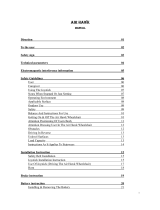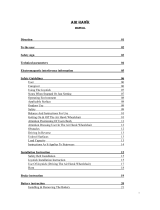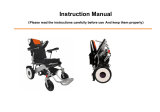
whether the brake has broken down. If it has, it can be adjusted and
resumed.
Frame: the frame surface coating should be wiped with a soft cloth
and should be kept clean; lubricant is prohibited. if the frame cracks,
please contact the supplier.
Service of controller: clean the controller and joystick with a cloth
dampened with a neutral diluted cleaner carefully. Never use abrasive
materials or alcoholic detergents for cleaning. Protect the controller
from damage during transportation of the wheelchair.
Motor: check if there is any increase in oil leakage or noise. If any,
please contact the supplier or manufacturer.
Maintenance of connector reliability: check that the screws and nuts
on the body are tightened frequently and promptly handle the
problems (if any) to ensure driving safety.
Seat back cushion: wash the seat cover and backrest with warm
water and diluted soapy water. Avoid keeping the wheelchair in a
damp place.
Electromagnetic brake: service brake. Let the wheelchair run
straight at the maximum speed on a flat asphalt pavement. Release
the controller joystick to automatically return it to the original position
and measure the distance from the time of releasing the joystick to
stopping. If the distance is larger than it was originally, the braking
effect is reduced; if the distance is more than 1.5m, contact the
supplier or manufacturer for repair.
Maintenance and service of battery:
1. Pay attention to the power indicator on the controller panel: if the
green indicator is not lit, charge the battery as soon as possible; if the
red indicator is lit, the battery capacity is seriously low. Charge the
battery immediately to prevent the battery voltage from getting too low,
thus affecting the battery's life.
2.The battery is marked with obvious positive and negative electrode
signs and a reliable connector is provided to ensure the normal
16 17
connection of the circuit. Non-specialized persons should not connect
the circuit.
3. The battery is maintenance-free and replenishment of
supplemental fluid is not required daily. During charging, the battery
temperature will rise, but should not exceed 45℃; if the temperature
exceeds 45℃, stop charging until the temperature drops below 35℃.
If the wheelchair is parked for a long time, recharge the battery at least
once a month.
4. The battery has its service life. If the trip mileage is significantly
different from the nominal mileage after long time of normal operation,
please replace the battery.
5. Do not use the battery at temperature of ≥50℃ or ≤-20℃.
6. Keep the battery clean and dry. Do not hit the battery with hard
objects. Keep the battery properly and keep it in a place out of reach of
children.
7. The power switch on the battery box cuts off the battery power and
reduces the natural power consumption of the battery. Turn off the
power switch on the battery box when the wheelchair is not being used
for a long time.
8. "Full capacity": develop the habit of maintaining the battery at full
capacity and charge the battery in a timely manner according to
usage, so that the battery is at "full capacity" long-term.
9. Replace battery
Press the power switch on the battery box to the "O" position for
battery replacement;
(1). If lead-acid batteries is used, left and right battery boxes are
provided and each battery box contains a lead-acid battery: red on the
battery indicates the positive electrode and black indicates the
negative electrode. The battery shall be replaced as follows:
a. Loosen the 6 self-tapping screws from inside of the electric
wheelchair (i.e. back of the battery box) and open the back cover, see
Figure 19. The methods are same for left side and right side;




















